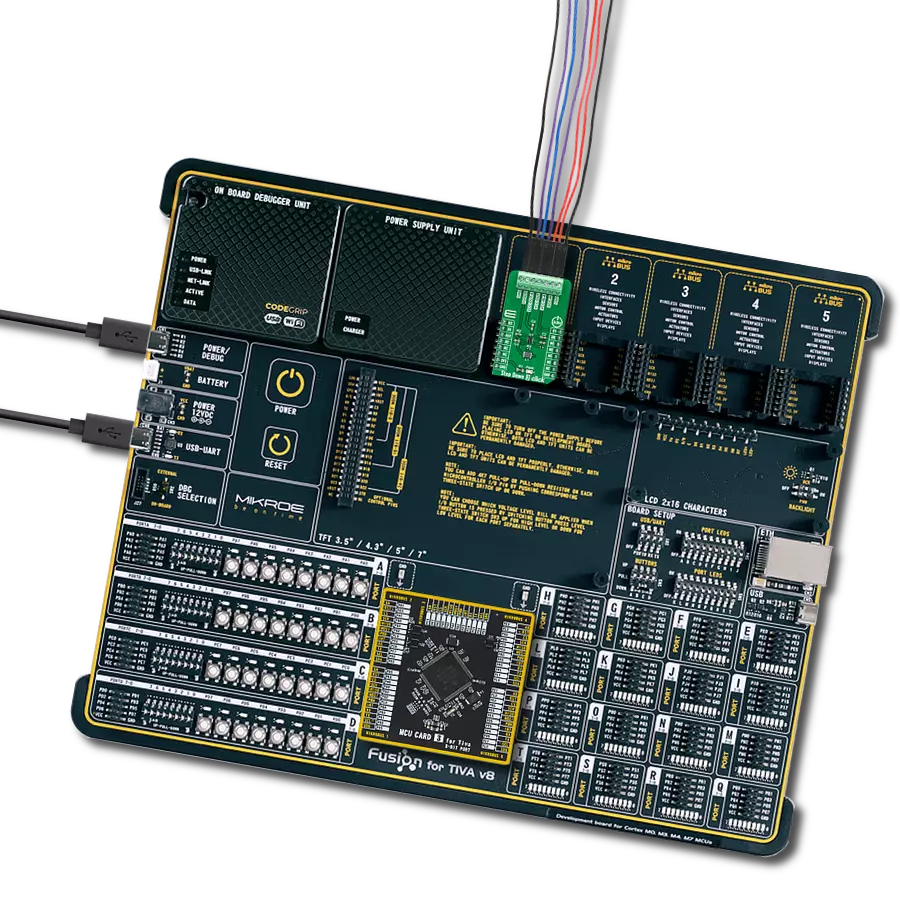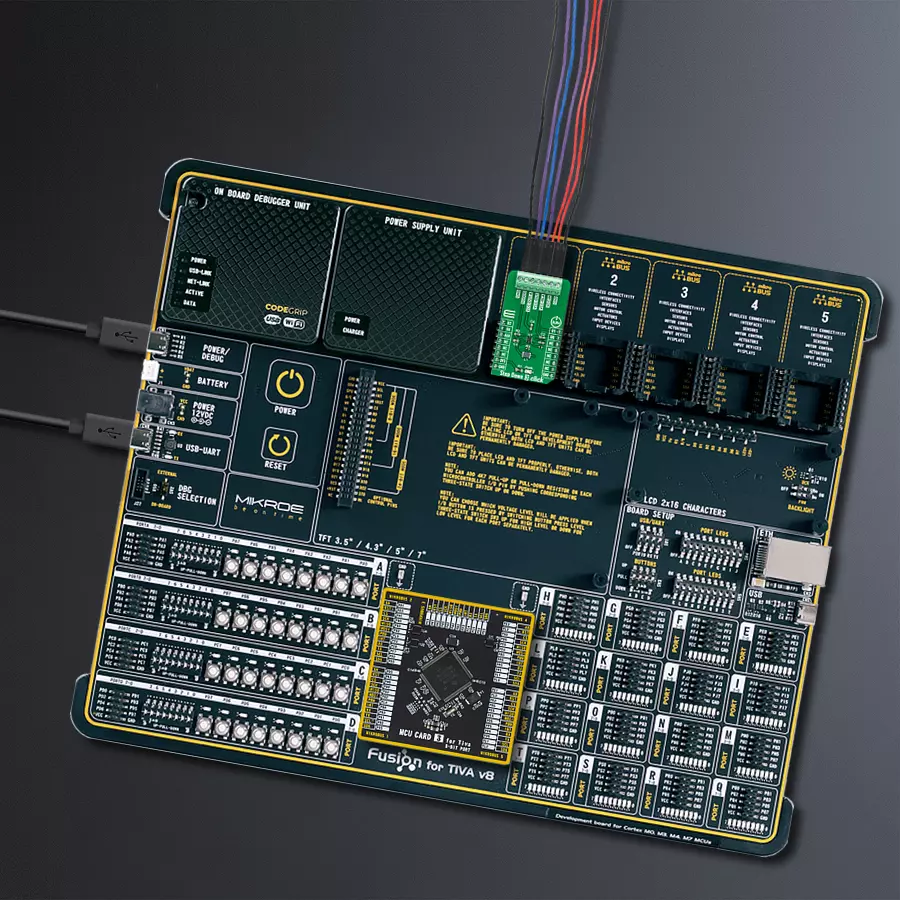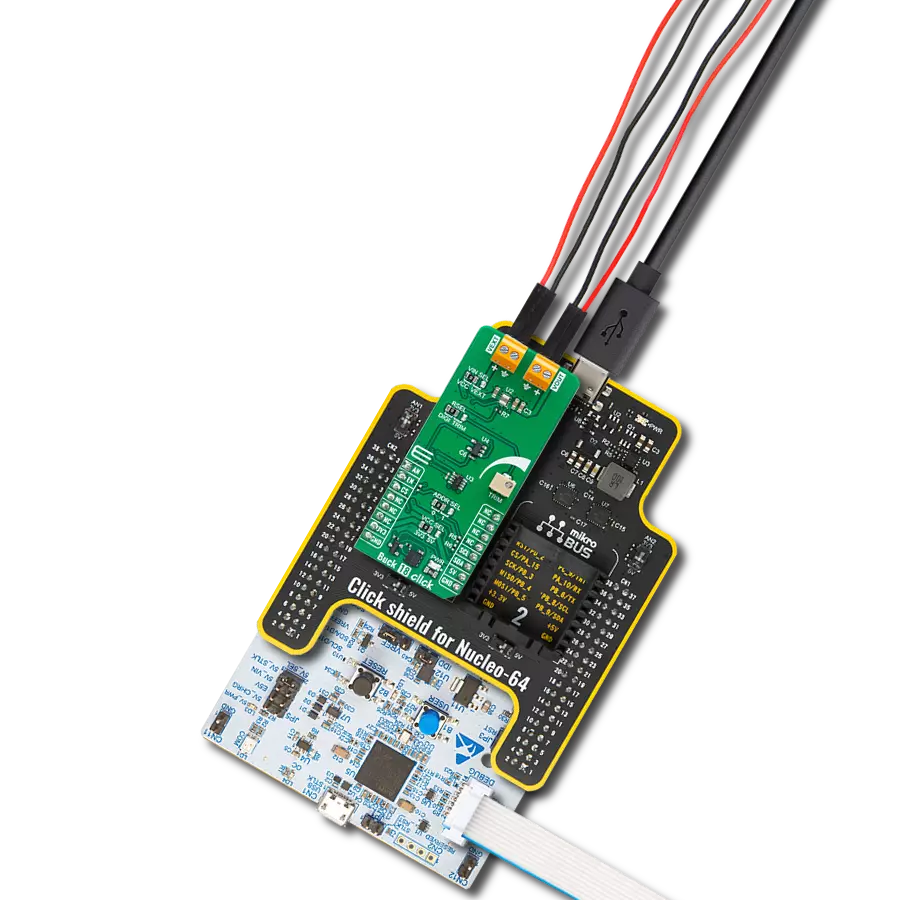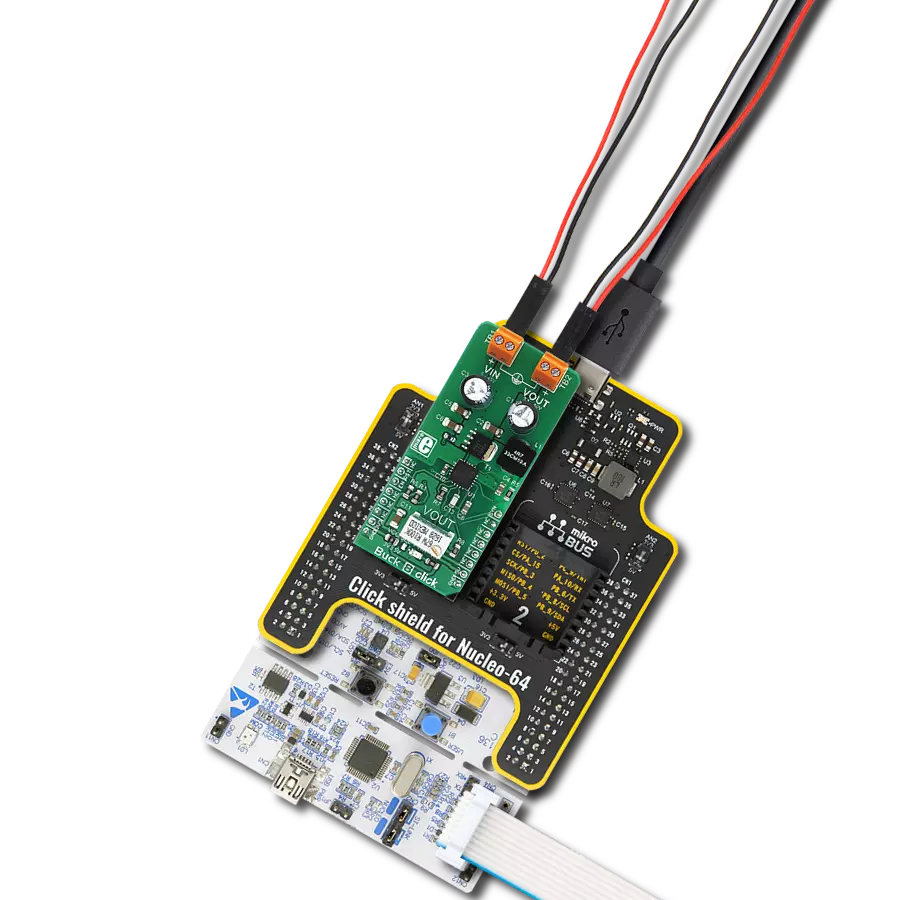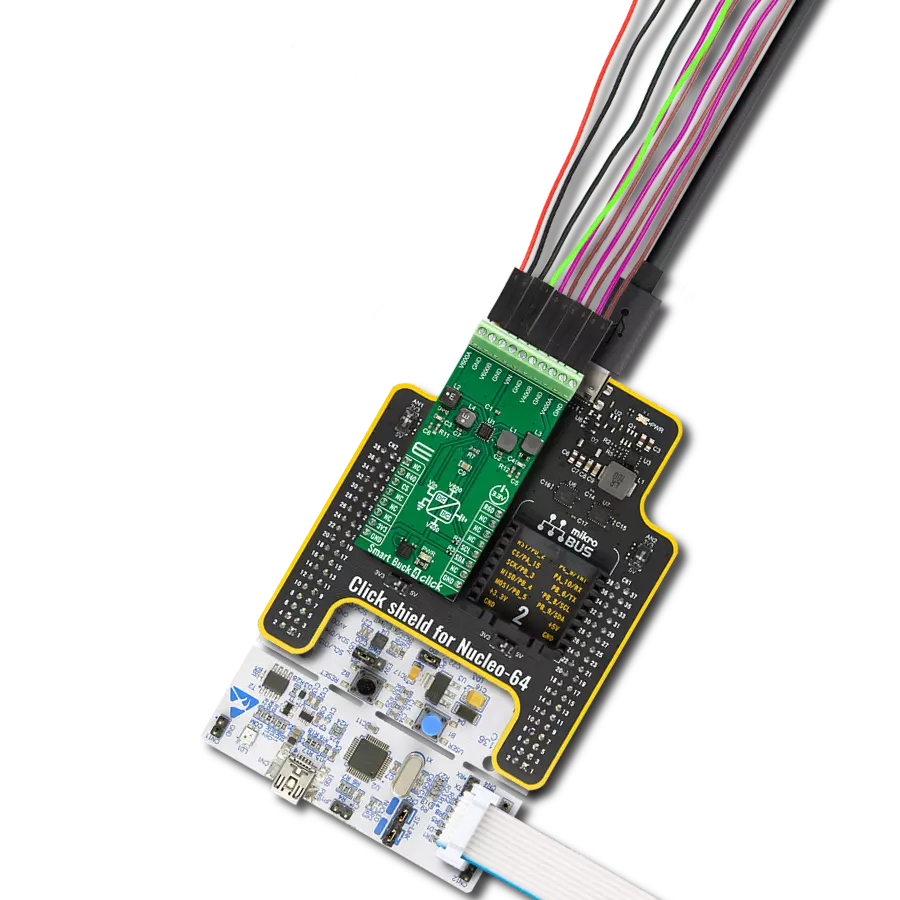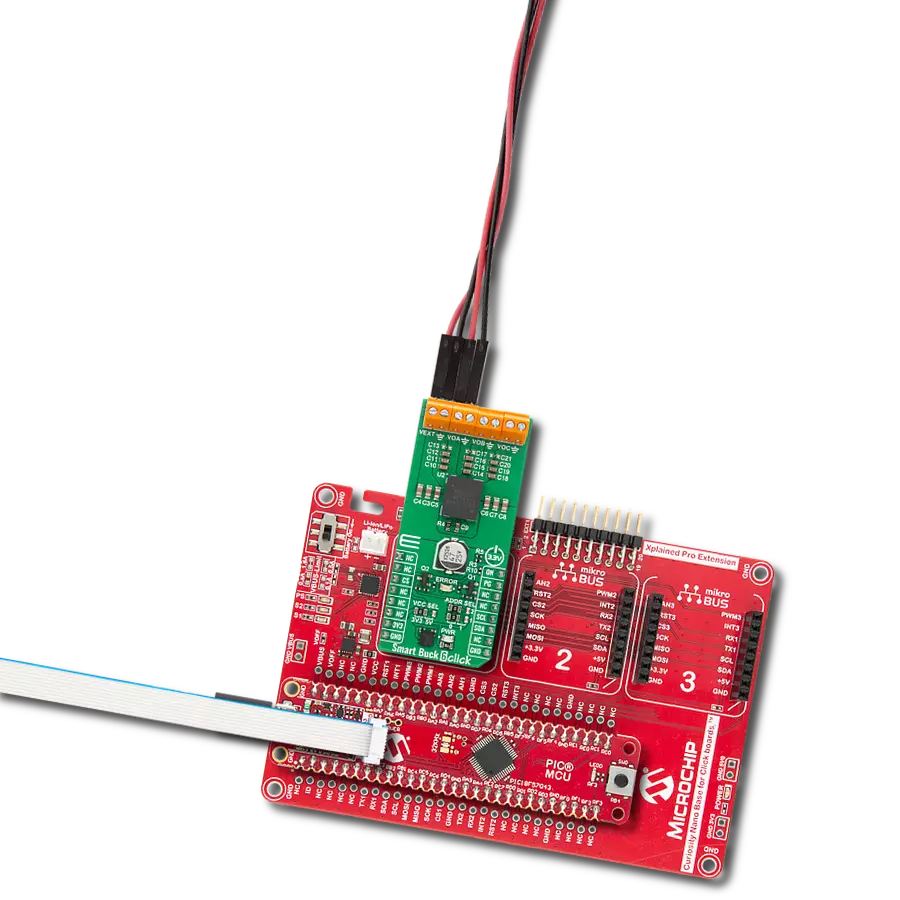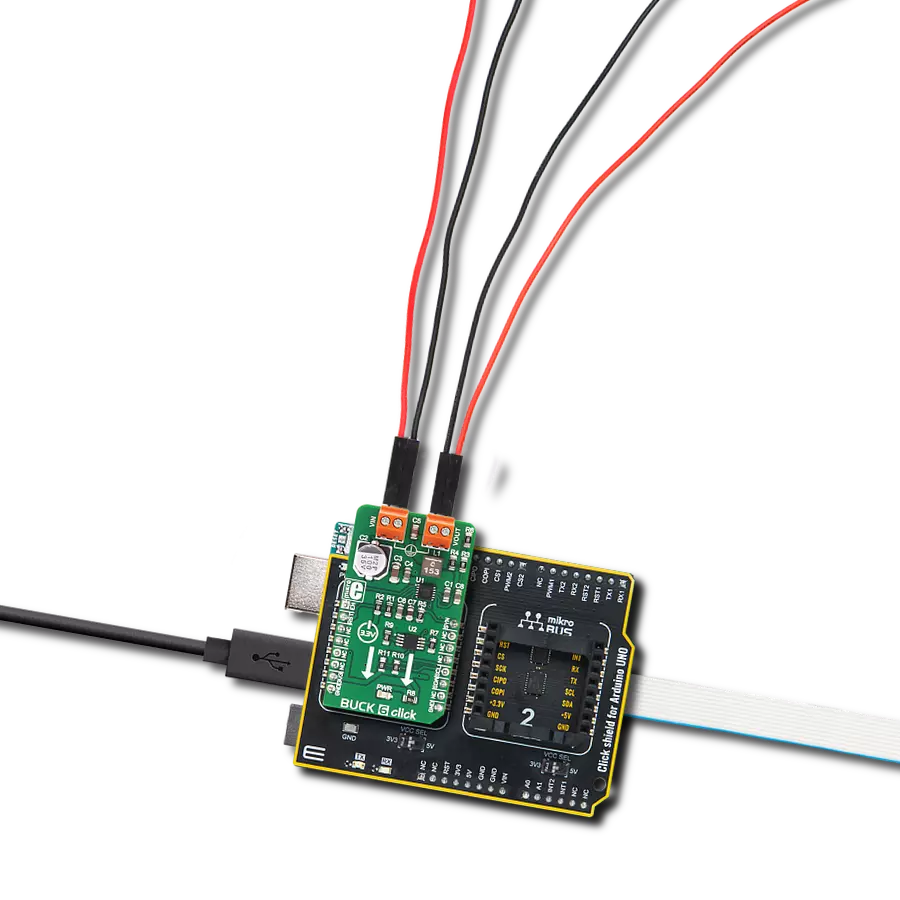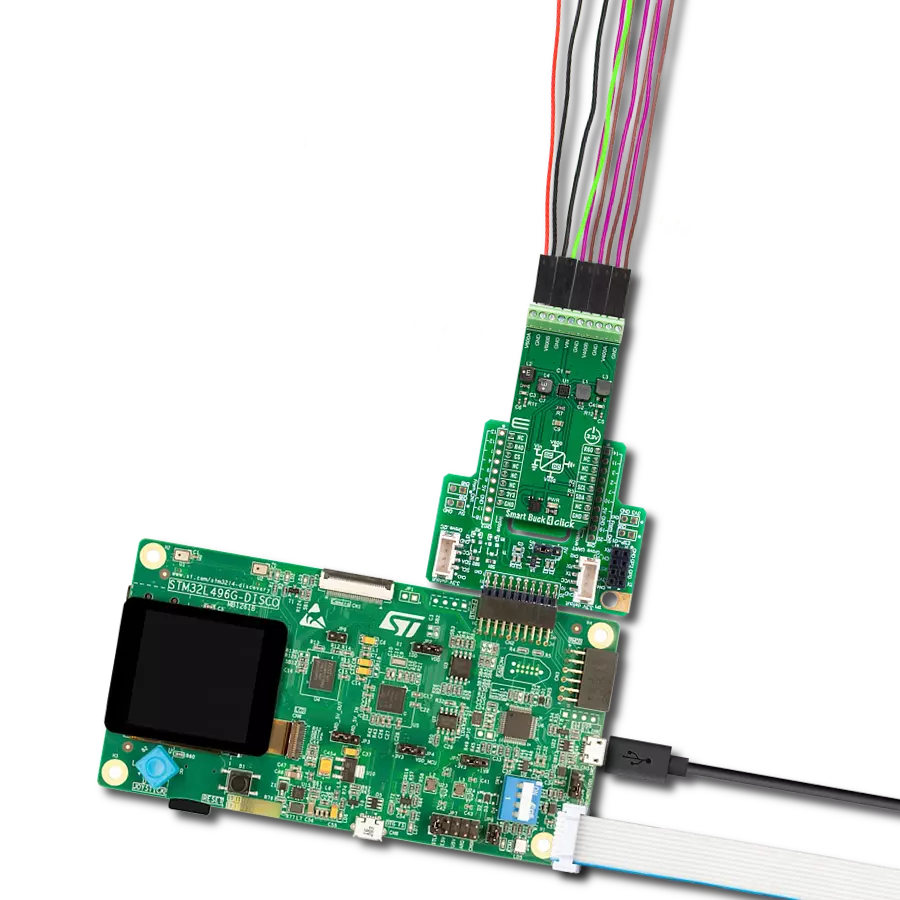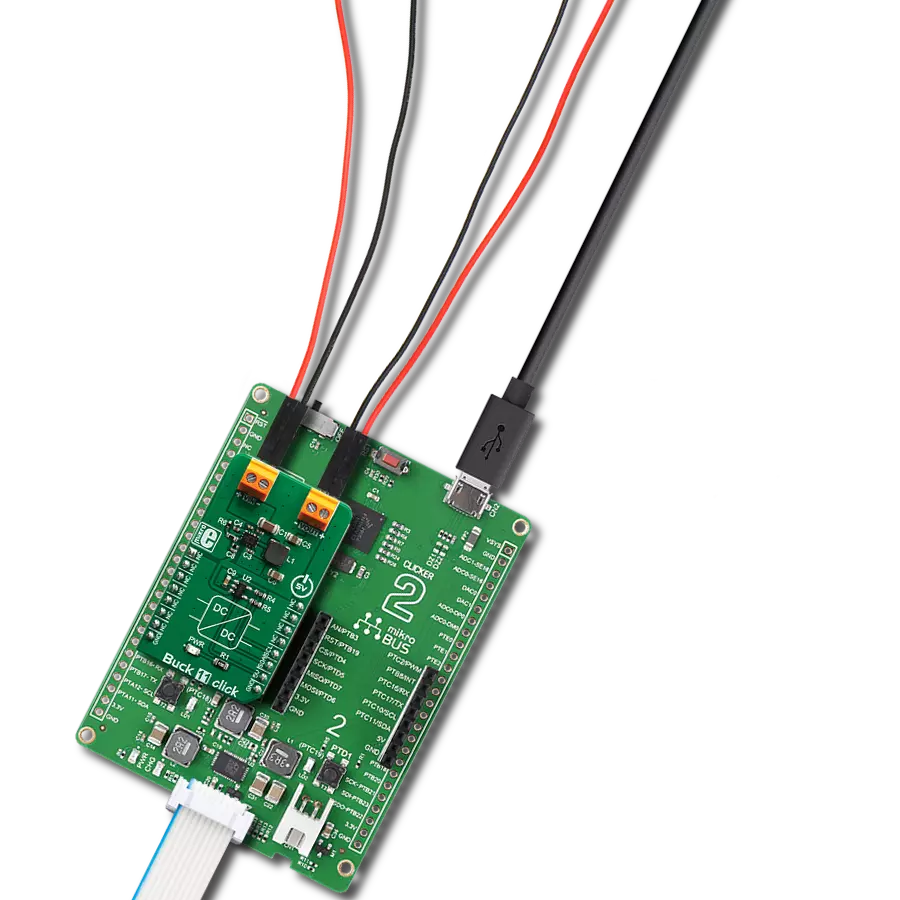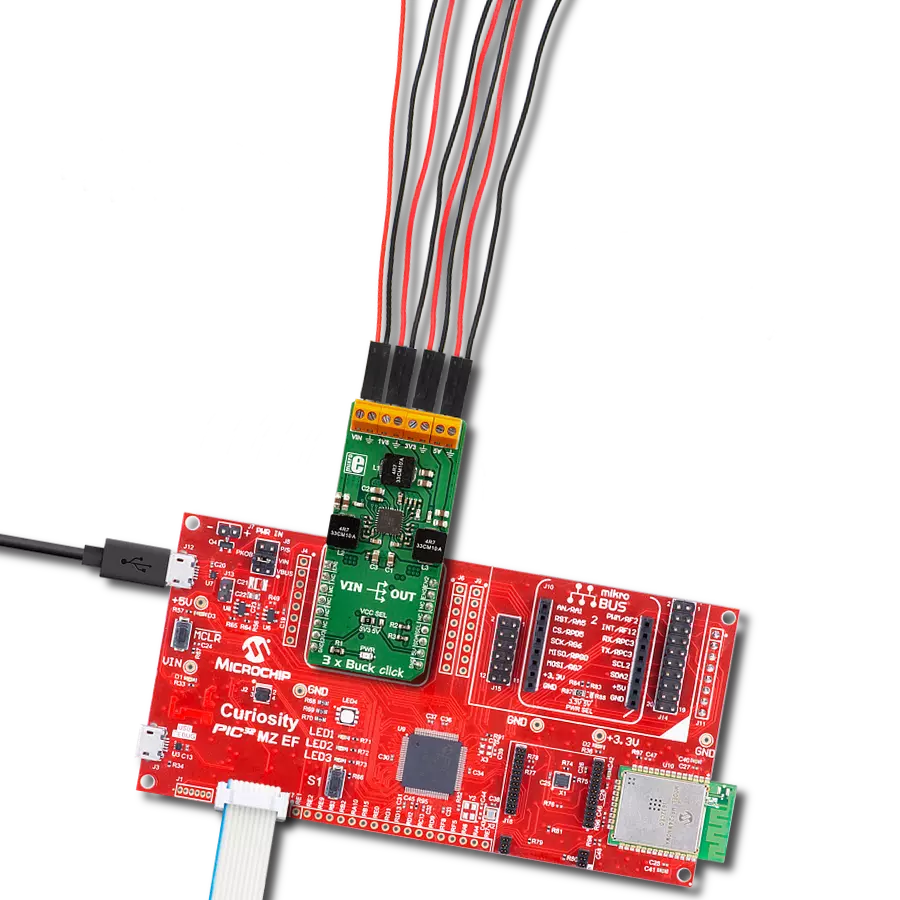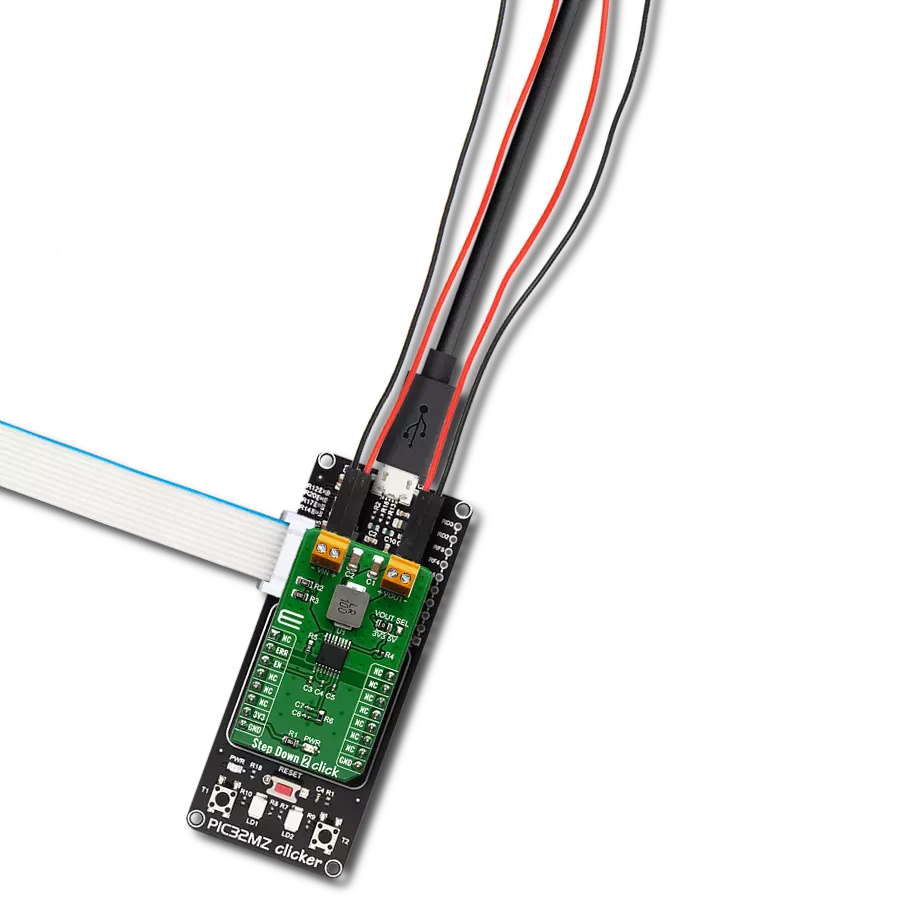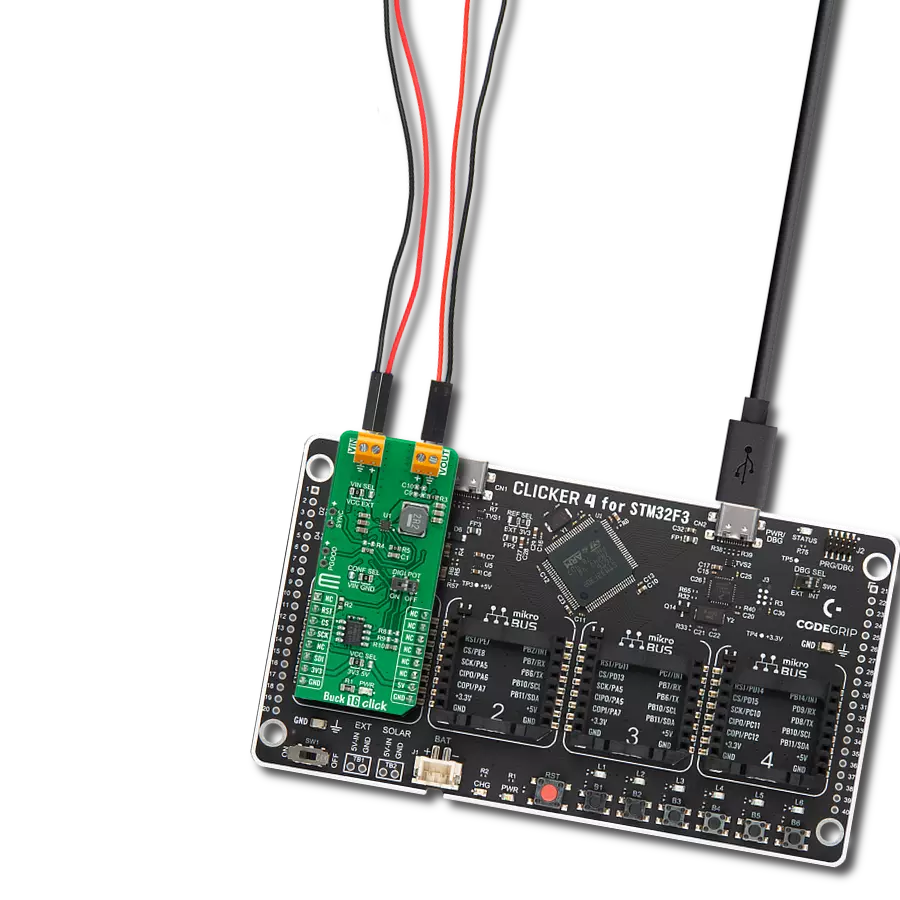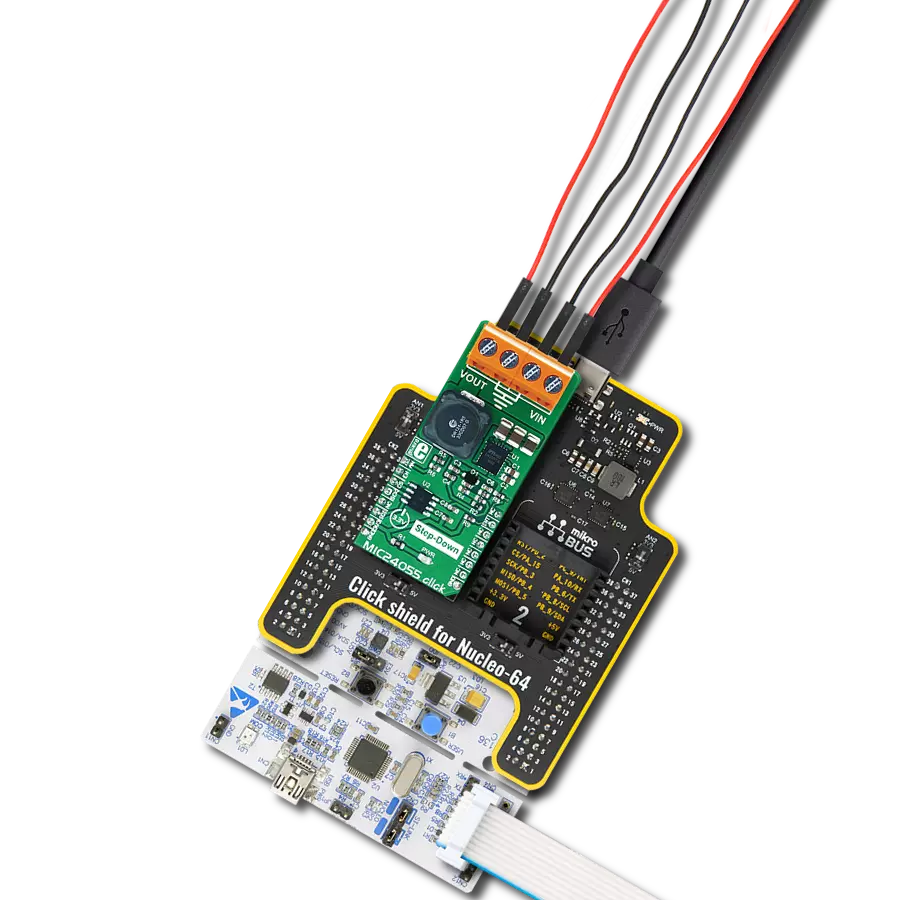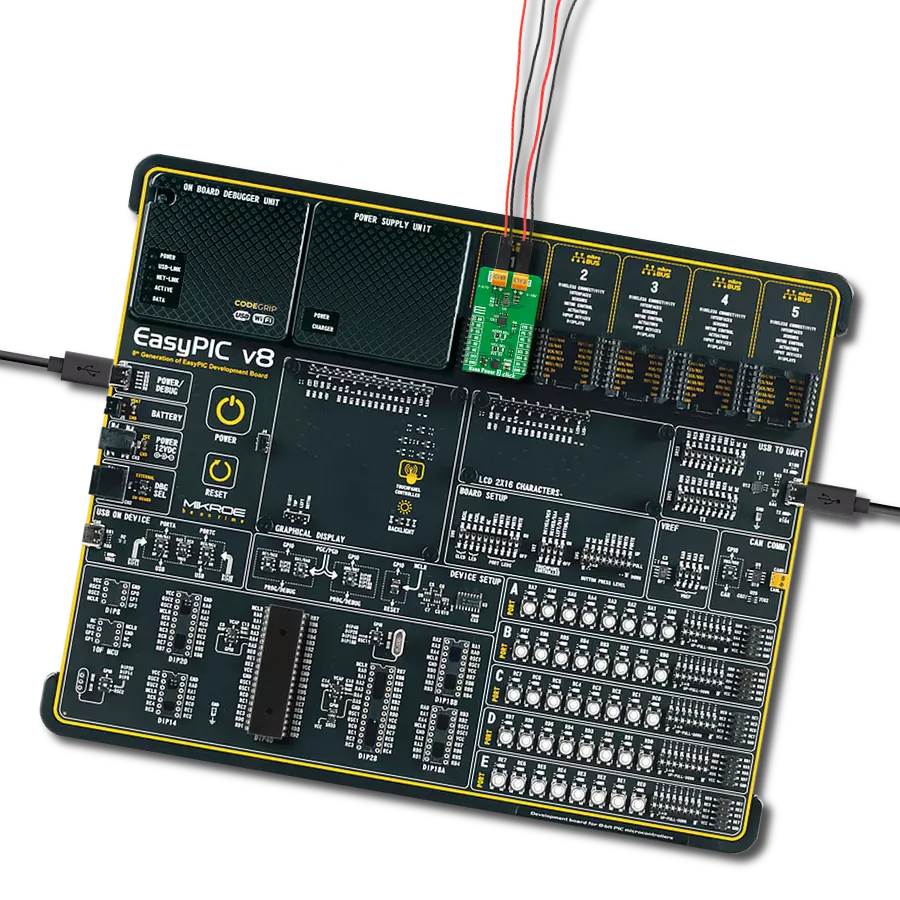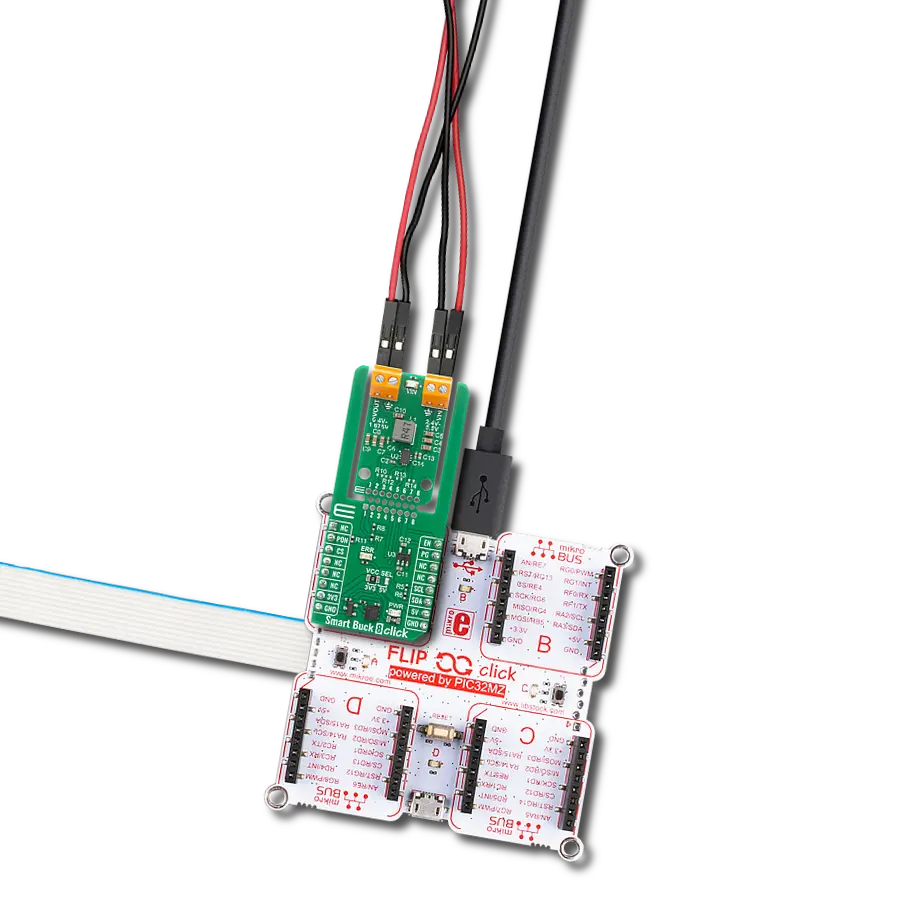Regulate the output voltage to a precise level and provide a stable power supply for various applications
A
A
Hardware Overview
How does it work?
Step Down 3 Click is based on the ST1PS03, an ultra-low quiescent new generation buck converter from STMicroelectronics. The ST1PS03 targets a small quiescent current consumption and guarantees high-efficiency operation even down to a few microampere loads. It can provide up to 400mA output current with an output voltage from 1.6V to 3.3V on the VCC-OUT terminal, selectable using three digital control pins routed to the INT, PWM, and AN pins of the mikroBUS™ socket, and an input voltage ranging from 1.8V to 5.5V appliable on VCC-IN terminal. The ST1PS03 is based on a hysteretic comparator that senses the coil ripple current, held constant in all operation modes. The ST1PS03 changes the switching frequency depending on the input supply voltage to maintain a continuous ripple current on the selected coil. It seamlessly transitions between PFM (pulse frequency
modulation) and PWM (pulse width modulation) mode with low ripple and good load transient response. During PWM mode (heavy load), the device operates in continuous conduction up to 400mA and a switching frequency of 2MHz maximum. The device enters 100% duty cycle operation if the input voltage comes close to the selected output voltage. The regulator is turned OFF during this mode, and the output pin is directly connected to the input pin through the internal high-side MOSFET. Once the input voltage exceeds the 100% duty cycle, the device restarts to switch and regulates the output voltage again. This Click board™ also has a Power Good comparator which monitors the selected output voltage and provides information on the appropriate PGOOD terminal. Step Down 3 Click communicates with MCU using several GPIO pins. The AUX pin routed to the CS pin of the mikroBUS™
socket controls the auxiliary output terminal labeled as VCC-OUT-A. It provides the same regulated voltage level as VCC-IN-a input voltage, with less drop on the load switch circuitry when the AUX pin and EN pin, routed to the RST pin of the mikroBUS™ socket, are tied high. The VCC-OUT-A terminal allows connecting/disconnecting the other system load to the output of the ST1PS03. This Click board™ can only be operated with a 3.3V logic voltage level. The board must perform appropriate logic voltage level conversion before using MCUs with different logic levels. However, the Click board™ comes equipped with a library containing functions and an example code that can be used as a reference for further development.
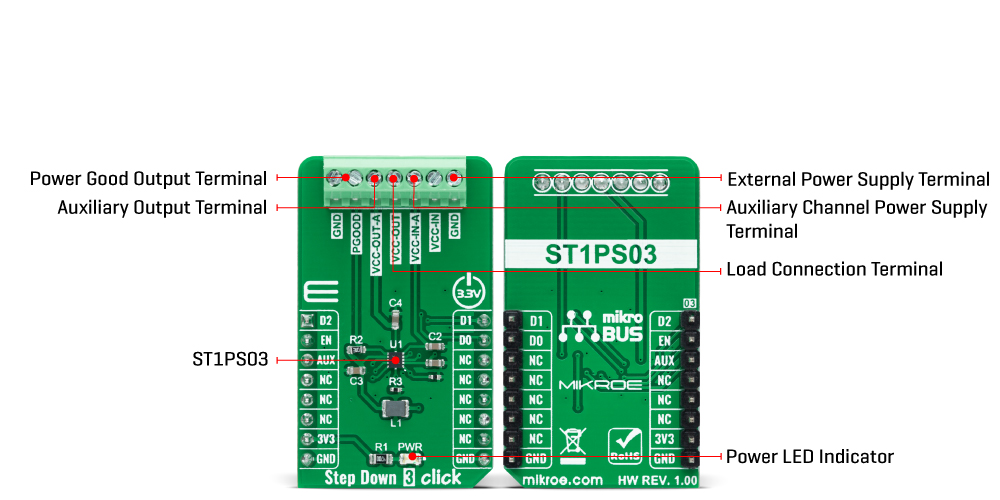
Features overview
Development board
Fusion for TIVA v8 is a development board specially designed for the needs of rapid development of embedded applications. It supports a wide range of microcontrollers, such as different 32-bit ARM® Cortex®-M based MCUs from Texas Instruments, regardless of their number of pins, and a broad set of unique functions, such as the first-ever embedded debugger/programmer over a WiFi network. The development board is well organized and designed so that the end-user has all the necessary elements, such as switches, buttons, indicators, connectors, and others, in one place. Thanks to innovative manufacturing technology, Fusion for TIVA v8 provides a fluid and immersive working experience, allowing access
anywhere and under any circumstances at any time. Each part of the Fusion for TIVA v8 development board contains the components necessary for the most efficient operation of the same board. An advanced integrated CODEGRIP programmer/debugger module offers many valuable programming/debugging options, including support for JTAG, SWD, and SWO Trace (Single Wire Output)), and seamless integration with the Mikroe software environment. Besides, it also includes a clean and regulated power supply module for the development board. It can use a wide range of external power sources, including a battery, an external 12V power supply, and a power source via the USB Type-C (USB-C) connector.
Communication options such as USB-UART, USB HOST/DEVICE, CAN (on the MCU card, if supported), and Ethernet is also included. In addition, it also has the well-established mikroBUS™ standard, a standardized socket for the MCU card (SiBRAIN standard), and two display options for the TFT board line of products and character-based LCD. Fusion for TIVA v8 is an integral part of the Mikroe ecosystem for rapid development. Natively supported by Mikroe software tools, it covers many aspects of prototyping and development thanks to a considerable number of different Click boards™ (over a thousand boards), the number of which is growing every day.
Microcontroller Overview
MCU Card / MCU
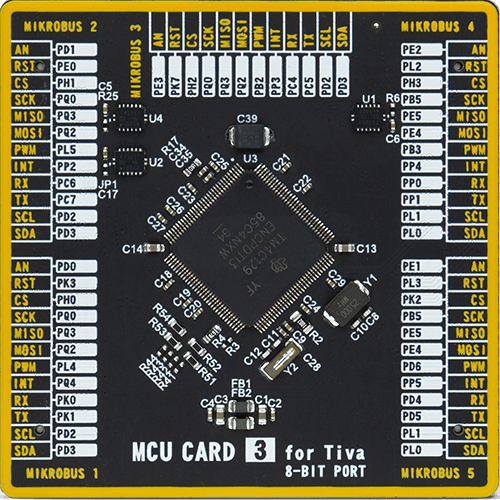
Type
8th Generation
Architecture
ARM Cortex-M4
MCU Memory (KB)
1024
Silicon Vendor
Texas Instruments
Pin count
128
RAM (Bytes)
262144
Used MCU Pins
mikroBUS™ mapper
Take a closer look
Click board™ Schematic

Step by step
Project assembly
Software Support
Library Description
This library contains API for Step Down 3 Click driver.
Key functions:
stepdown3_enable_deviceThis function enables the auxiliary output (VOUT_AUX) by setting the AUX pin to HIGH logic state.stepdown3_enable_aux_outputThis function disables the auxiliary output (VOUT_AUX) by setting the AUX pin to LOW logic state.stepdown3_set_output_voltageThis function sets the output voltage by setting the D2, D1, and D0 pins to a desired state.
Open Source
Code example
The complete application code and a ready-to-use project are available through the NECTO Studio Package Manager for direct installation in the NECTO Studio. The application code can also be found on the MIKROE GitHub account.
/*!
* @file main.c
* @brief Step Down 3 Click Example.
*
* # Description
* This example demonstrates the use of Step Down 3 Click board by
* iterating through the entire output voltage range.
*
* The demo application is composed of two sections :
*
* ## Application Init
* Initializes the driver and logger, then enables the Click board and disables
* the auxiliary output.
*
* ## Application Task
* Changes the output voltage every 3 seconds and displays the set voltage output value
* on the USB UART.
*
* @author Stefan Filipovic
*
*/
#include "board.h"
#include "log.h"
#include "stepdown3.h"
static stepdown3_t stepdown3; /**< Step Down 3 Click driver object. */
static log_t logger; /**< Logger object. */
void application_init ( void )
{
log_cfg_t log_cfg; /**< Logger config object. */
stepdown3_cfg_t stepdown3_cfg; /**< Click config object. */
/**
* Logger initialization.
* Default baud rate: 115200
* Default log level: LOG_LEVEL_DEBUG
* @note If USB_UART_RX and USB_UART_TX
* are defined as HAL_PIN_NC, you will
* need to define them manually for log to work.
* See @b LOG_MAP_USB_UART macro definition for detailed explanation.
*/
LOG_MAP_USB_UART( log_cfg );
log_init( &logger, &log_cfg );
log_info( &logger, " Application Init " );
// Click initialization.
stepdown3_cfg_setup( &stepdown3_cfg );
STEPDOWN3_MAP_MIKROBUS( stepdown3_cfg, MIKROBUS_1 );
if ( DIGITAL_OUT_UNSUPPORTED_PIN == stepdown3_init( &stepdown3, &stepdown3_cfg ) )
{
log_error( &logger, " Communication init." );
for ( ; ; );
}
stepdown3_enable_device ( &stepdown3 );
stepdown3_disable_aux_output ( &stepdown3 );
log_info( &logger, " Application Task " );
}
void application_task ( void )
{
static uint8_t vout = STEPDOWN3_OUT_VOLTAGE_1V6;
stepdown3_set_output_voltage ( &stepdown3, vout );
switch ( vout )
{
case STEPDOWN3_OUT_VOLTAGE_1V6:
{
log_printf( &logger, " Output voltage: 1.6 V\r\n\n" );
break;
}
case STEPDOWN3_OUT_VOLTAGE_1V8:
{
log_printf( &logger, " Output voltage: 1.8 V\r\n\n" );
break;
}
case STEPDOWN3_OUT_VOLTAGE_2V1:
{
log_printf( &logger, " Output voltage: 2.1 V\r\n\n" );
break;
}
case STEPDOWN3_OUT_VOLTAGE_2V5:
{
log_printf( &logger, " Output voltage: 2.5 V\r\n\n" );
break;
}
case STEPDOWN3_OUT_VOLTAGE_2V7:
{
log_printf( &logger, " Output voltage: 2.7 V\r\n\n" );
break;
}
case STEPDOWN3_OUT_VOLTAGE_2V8:
{
log_printf( &logger, " Output voltage: 2.8 V\r\n\n" );
break;
}
case STEPDOWN3_OUT_VOLTAGE_3V0:
{
log_printf( &logger, " Output voltage: 3.0 V\r\n\n" );
break;
}
case STEPDOWN3_OUT_VOLTAGE_3V3:
{
log_printf( &logger, " Output voltage: 3.3 V\r\n\n" );
break;
}
}
if ( ++vout > STEPDOWN3_OUT_VOLTAGE_3V3 )
{
vout = STEPDOWN3_OUT_VOLTAGE_1V6;
}
Delay_ms ( 1000 );
Delay_ms ( 1000 );
Delay_ms ( 1000 );
}
int main ( void )
{
/* Do not remove this line or clock might not be set correctly. */
#ifdef PREINIT_SUPPORTED
preinit();
#endif
application_init( );
for ( ; ; )
{
application_task( );
}
return 0;
}
// ------------------------------------------------------------------------ END
Additional Support
Resources
Category:Buck
